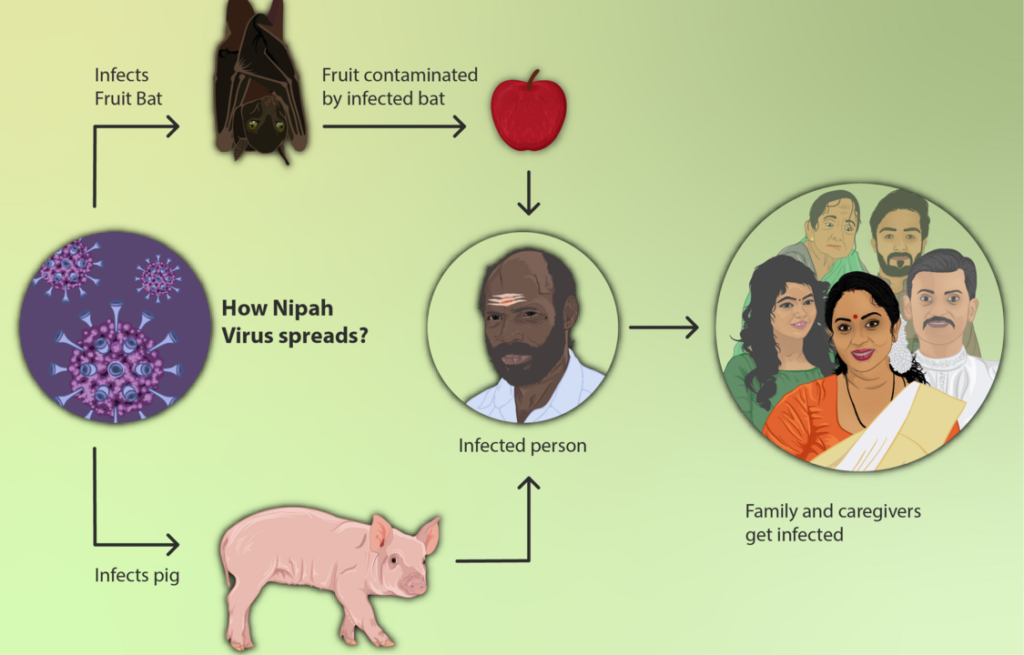Since its discovery in 1999 during an outbreak among Malaysian pig farmers, the highly contagious zoonotic virus known as the Nipah virus( NiV) has come to light as a deadly and potent threat.
Table of Contents
This virus, primarily transmitted from animals to humans, has also exhibited the ability to spread directly between people. It manifests a spectrum of illnesses in infected individuals, ranging from asymptomatic infections to severe respiratory issues and even fatal encephalitis. Furthermore, it wreaks havoc in the animal kingdom, causing devastating economic losses for farmers.
While Nipah virus has been responsible for a limited number of outbreaks primarily in Asian regions, its capacity to infect a wide range of animals and its lethal impact on humans underscore its significance as a looming public health concern.
In this comprehensive article, we will delve into the causes, symptoms, transmission, treatment, prevention, and recent outbreaks associated with Nipah virus, shedding light on the critical aspects of this deadly viral infection.
Causes of Nipah Virus
Fruit bats of the Pteropodidae family, commonly known as flying foxes, serve as the natural host of Nipah virus. These bats harbor the virus without showing any symptoms of illness. Nipah virus can be transmitted from these bats to other animals, such as pigs, and from there to humans. The virus can also be transmitted directly from human to human.
It is important to note that there is no specific treatment or vaccine available for Nipah virus infections, neither for humans nor for animals. This lack of medical countermeasures adds to the challenges of managing Nipah virus outbreaks.
Nipah Virus Symptoms
Nipah virus infections in humans can result in a wide range of symptoms, from mild to severe. The incubation period, which is the time between infection and the onset of symptoms, typically ranges from 4 to 14 days. However, it can extend to as long as 45 days.
The initial symptoms of Nipah virus infection are often non-specific and flu-like. They may include fever, headache, cough, sore throat, and difficulty breathing. This phase can last for 3 to 14 days and may lead to more severe respiratory illness.
A particularly concerning aspect of Nipah virus infection is its potential to cause encephalitis, characterized by swelling of the brain. Individuals with encephalitis may experience drowsiness, disorientation, mental confusion, seizures, and even coma. In severe cases, encephalitis can progress rapidly, leading to death within 24 to 48 hours.
The fatality rate of Nipah virus infection can range from 40% to 75%, making it a highly lethal pathogen. Additionally, survivors of Nipah virus infection may face long-term side effects, including persistent convulsions and personality changes. In some instances, Nipah virus can remain dormant or latent in the body, causing symptoms and sometimes death months or even years after the initial exposure.
Nipah Virus Treatment
Currently, there are no licensed treatments available for Nipah virus (NiV) infection in either humans or animals. Treatment for NiV-infected individuals is primarily supportive in nature. Patients receive care to manage their symptoms, which includes rest, hydration, and treatment of specific symptoms as they arise.
However, researchers and healthcare professionals are actively working on developing immunotherapeutic treatments, particularly monoclonal antibody therapies, for Nipah virus infections. One such monoclonal antibody, m102.4, has completed phase 1 clinical trials and has been used on a compassionate use basis. Additionally, the antiviral treatment remdesivir has shown effectiveness in nonhuman primates when administered as post-exposure prophylaxis, and it may complement immunotherapeutic treatments. The drug ribavirin was used to treat a small number of patients in the initial Malaysian NiV outbreak, but its efficacy in humans remains unclear.
Nipah Virus Transmission

Nipah virus (NiV) can spread to humans through several routes, including:
- Direct Contact with Infected Animals: Individuals who come into direct contact with sick animals, such as bats or pigs, or their body fluids (including blood, urine, or saliva), are at risk of infection. This mode of transmission was prominent in the first known NiV outbreak in Malaysia, where pig farmers faced infection from their swine.
- Consuming Contaminated Food Products: In regions like Bangladesh and India, Nipah virus infections have been linked to the consumption of fruits or fruit products, such as raw date palm juice, that were contaminated with urine or saliva from infected fruit bats. These animals play a significant role in transmitting the virus to humans via foodborne contamination.
- Human-to-Human Transmission: During later outbreaks in Bangladesh and India, human-to-human transmission of Nipah virus occurred. Close contact with infected individuals or their bodily fluids, including nasal or respiratory droplets, urine, or blood, served as a vector for the virus.
- Environmental Exposure: While less understood, there is a possibility of environmental exposure to Nipah virus through contaminated bodily fluids, including fruits. However, further research is needed to comprehensively investigate viral persistence in bodily fluids and the environment.
Nipah Virus Outbreaks
Nipah virus outbreaks have primarily occurred in South and Southeast Asia. The virus made its debut during an outbreak among pig farmers in Malaysia in 1999, which also affected neighboring Singapore. During this initial outbreak, several human infections and deaths resulted from direct contact with sick pigs or their contaminated tissues.
Subsequent outbreaks in Bangladesh and India exhibited different modes of transmission. In these regions, the consumption of fruits or fruit products, especially raw date palm juice, contaminated with urine or saliva from infected fruit bats, was the most probable source of infection. Notably, human-to-human transmission of Nipah virus was reported during these later outbreaks, particularly among family members and caregivers of infected patients.
Nipah Virus Prevention
Preventing Nipah virus infection involves several key measures:
- Avoiding Contact with Infected Animals: Individuals residing in areas where Nipah virus outbreaks have occurred should steer clear of direct contact with sick pigs, bats, or their bodily fluids, such as blood, urine, or saliva.
- Safe Food Practices: It is advisable not to consume fruits that have fallen from trees or fruits that may have been bitten by animals. Thoroughly washing fruits before consumption is crucial. Additionally, avoiding the consumption of raw date palm sap, which can become contaminated by bat urine or saliva, is a vital preventive measure.
- Practicing Good Hygiene: Frequent handwashing with soap and water is an essential practice, particularly after caring for or visiting sick individuals. This simple yet effective measure can significantly reduce the risk of virus transmission.
- Protection During Outbreaks: During Nipah virus outbreaks, it is imperative to follow public health recommendations, which may include the use of personal protective equipment when caring for infected individuals and avoiding large gatherings.
Nipah Virus Incubation Period
The incubation period for Nipah virus (NiV) infections typically spans from 4 to 14 days, although it can extend up to 45 days. This crucial period represents the time between initial infection and the onset of noticeable symptoms. Understanding this timeline is vital for both diagnosis and outbreak control.
Nipah virus poses a significant threat as a zoonotic pathogen that can cause severe diseases in both animals and humans. Its mode of transmission from animals to humans, often through contaminated food or direct contact, highlights the importance of preventive measures, especially in regions where outbreaks have occurred. With no specific treatment or vaccine currently available, vigilance, hygiene, and public health interventions remain the primary tools for managing and preventing Nipah virus infections. As our understanding of this virus continues to evolve, ongoing research and surveillance are crucial in safeguarding against this deadly zoonotic threat.
In conclusion, Nipah virus serves as a stark reminder of the complex interplay between human and animal health and the need for continued efforts to monitor, prevent, and respond to emerging infectious diseases in our interconnected world.
References:







